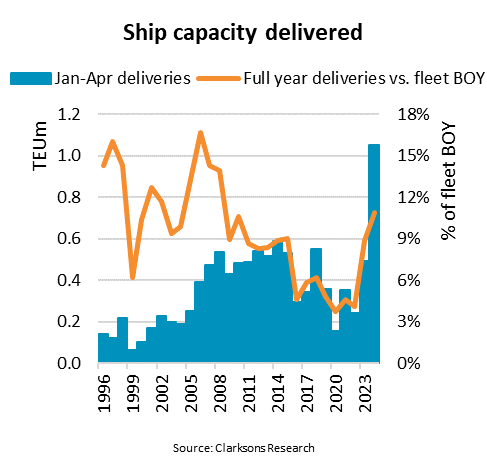BIMCO Shipping Number of the Week: Container ship deliveries hit new YTD record of 1m TEU
“In 2023, 2.3 million TEU of container ship capacity was delivered, beating the former all-time high by 37%. Year-to-date another record has been set as more than 1 million TEU has already been delivered during the first four months of the year, an increase of nearly 80% compared to the previous record,” says Niels Rasmussen, Chief Shipping Analyst at BIMCO.
As ship recycling has so far only retired 19 smaller ships, the fleet has expanded by nearly 1 million TEU, a 3.5% increase compared to the beginning of the year. This adds to last year's fleet growth of 8.2%.
“Due to record deliveries the order book has declined. However, as 1.8 million TEU has been contracted during 2023 and 2024, it has only declined by 1 million TEU and now stands at 6.1 million TEU, 21% of the current fleet size. As a result, the order book’s share of the fleet is more than twice the size than it was before the COVID pandemic and liner operators’ contracting spree began,” says Rasmussen.
The order book contains 2 million TEU for delivery in 2024 and delivery volumes for the year is on target to exceed 3 million TEU, 30% higher than last year’s record. In 2025, deliveries should end just below 2 million TEU, the third highest deliveries in one year only exceeded in 2023 and 2024.
Despite this, deliveries are still some way off the record when seen in relation to the size of the fleet. In 2024, we expect deliveries to reach 11% of fleet capacity at the beginning of the year. That was most recently beaten in 2008 when deliveries made up 14% of the fleet.
The record high ship deliveries were expected to create significant oversupply in the market, and while this did impact the market in 2023, it appears that deliveries this year instead contribute to keeping global container trade moving.
Due to the rerouting of ships via the Cape of Good Hope following attacks in the Red Sea by Houthis, about 10% more capacity is needed to manage global container trades. Capacity needed to manage any market growth should be added to those 10%.
“When ships start increasing sailings via the Red Sea and the Suez Canal, we will most likely see significant oversupply. Between 2019 and 2023, the fleet grew 21% while container volumes only grew 4%. Between 2023 and 2025, the fleet is expected to grow another 15%,” says Rasmussen.

Source: BIMCO
